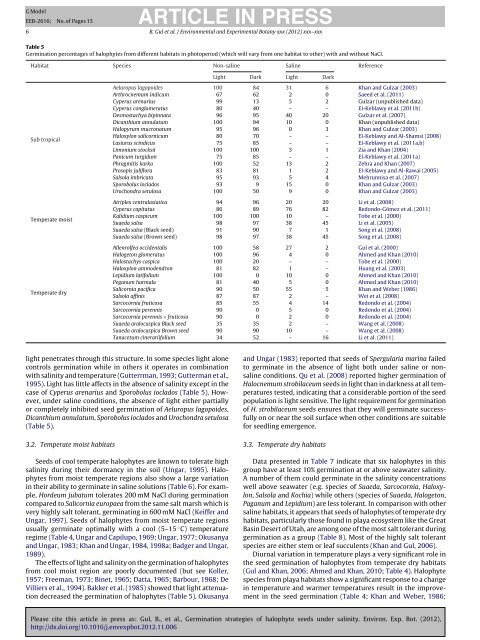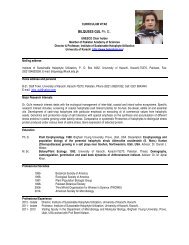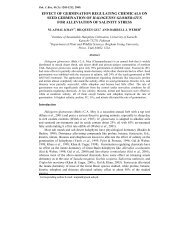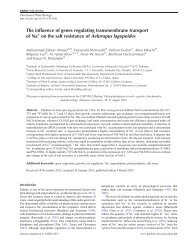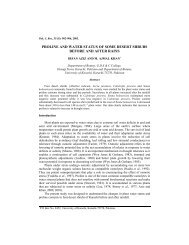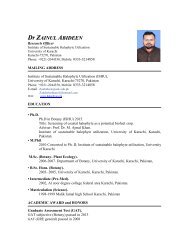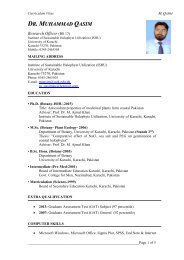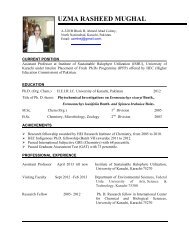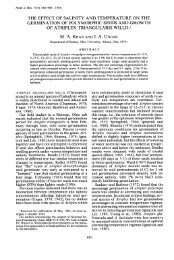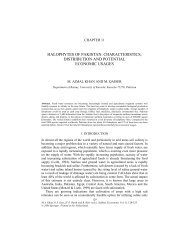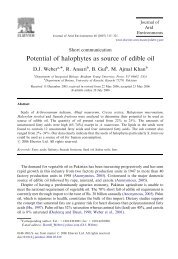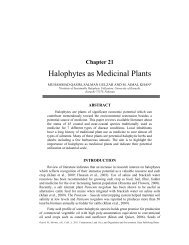Germination strategies of halophyte seeds under ... - ResearchGate
Germination strategies of halophyte seeds under ... - ResearchGate
Germination strategies of halophyte seeds under ... - ResearchGate
You also want an ePaper? Increase the reach of your titles
YUMPU automatically turns print PDFs into web optimized ePapers that Google loves.
ARTICLE IN PRESS<br />
G Model<br />
EEB-2616; No. <strong>of</strong> Pages 15<br />
6 B. Gul et al. / Environmental and Experimental Botany xxx (2012) xxx–xxx<br />
Table 5<br />
<strong>Germination</strong> percentages <strong>of</strong> <strong>halophyte</strong>s from different habitats in photoperiod (which will vary from one habitat to other) with and without NaCl.<br />
Habitat Species Non-saline Saline Reference<br />
Light Dark Light Dark<br />
Sub tropical<br />
Temperate moist<br />
Temperate dry<br />
Aeluropus lagopoides 100 84 31 6 Khan and Gulzar (2003)<br />
Arthrocnemum indicum 67 62 2 0 Saeed et al. (2011)<br />
Cyperus arenarius 99 13 5 2 Gulzar (unpublished data)<br />
Cyperus conglomeratus 80 40 – – El-Keblawy et al. (2011b)<br />
Desmostachya bipinnata 96 95 40 20 Gulzar et al. (2007)<br />
Dicanthium annulatum 100 94 10 0 Khan (unpublished data)<br />
Halopyrum mucronatum 95 96 0 3 Khan and Gulzar (2003)<br />
Haloxylon salicornicum 80 70 – – El-Keblawy and Al-Shamsi (2008)<br />
Lasiurus scindicus 75 85 – – El-Keblawy et al. (2011a,b)<br />
Limonium stocksii 100 100 3 1 Zia and Khan (2004)<br />
Panicum turgidum 75 85 – – El-Keblawy et al. (2011a)<br />
Phragmitis karka 100 52 13 2 Zehra and Khan (2007)<br />
Prosopis juliflora 83 81 1 2 El-Keblawy and Al-Rawai (2005)<br />
Salsola imbricata 95 93 5 4 Mehrunnisa et al. (2007)<br />
Sporobolus ioclados 93 9 15 0 Khan and Gulzar (2003)<br />
Urochondra setulosa 100 50 9 0 Khan and Gulzar (2003)<br />
Atriplex centralasiatica 94 96 20 20 Li et al. (2008)<br />
Cyperus capitatus 86 89 76 82 Redondo-Gómez et al. (2011)<br />
Kalidium caspicum 100 100 10 – Tobe et al. (2000)<br />
Suaeda salsa 98 97 38 45 Li et al. (2005)<br />
Suaeda salsa (Black seed) 91 90 7 1 Song et al. (2008)<br />
Suaeda salsa (Brown seed) 98 97 38 45 Song et al. (2008)<br />
Allenrolfea occidentalis 100 58 27 2 Gul et al. (2000)<br />
Halogeton glomeratus 100 96 4 0 Ahmed and Khan (2010)<br />
Halostachys caspica 100 20 – – Tobe et al. (2000)<br />
Haloxylon ammodendron 81 82 1 – Huang et al. (2003)<br />
Lepidium latifolium 100 0 10 0 Ahmed and Khan (2010)<br />
Peganum harmala 81 40 5 0 Ahmed and Khan (2010)<br />
Salicornia pacifica 90 50 55 5 Khan and Weber (1986)<br />
Salsola affinis 87 87 2 – Wei et al. (2008)<br />
Sarcocornia fruticosa 85 55 4 14 Redondo et al. (2004)<br />
Sarcocornia perennis 90 0 5 0 Redondo et al. (2004)<br />
Sarcocornia perennis × fruticosa 90 0 2 0 Redondo et al. (2004)<br />
Suaeda aralocaspica Black seed 35 35 2 – Wang et al. (2008)<br />
Suaeda aralocaspica Brown seed 90 90 10 – Wang et al. (2008)<br />
Tanacetum cinerariifolium 34 52 – 16 Li et al. (2011)<br />
light penetrates through this structure. In some species light alone<br />
controls germination while in others it operates in combination<br />
with salinity and temperature (Gutterrman, 1993; Gutterman et al.,<br />
1995). Light has little affects in the absence <strong>of</strong> salinity except in the<br />
case <strong>of</strong> Cyperus arenarius and Sporobolus ioclados (Table 5). However,<br />
<strong>under</strong> saline conditions, the absence <strong>of</strong> light either partially<br />
or completely inhibited seed germination <strong>of</strong> Aeluropus lagopoides,<br />
Dicanthium annulatum, Sporobolus ioclados and Urochondra setulosa<br />
(Table 5).<br />
3.2. Temperate moist habitats<br />
Seeds <strong>of</strong> cool temperate <strong>halophyte</strong>s are known to tolerate high<br />
salinity during their dormancy in the soil (Ungar, 1995). Halophytes<br />
from moist temperate regions also show a large variation<br />
in their ability to germinate in saline solutions (Table 6). For example,<br />
Hordeum jubatum tolerates 200 mM NaCl during germination<br />
compared to Salicornia europaea from the same salt marsh which is<br />
very highly salt tolerant, germinating in 600 mM NaCl (Keiffer and<br />
Ungar, 1997). Seeds <strong>of</strong> <strong>halophyte</strong>s from moist temperate regions<br />
usually germinate optimally with a cool (5–15 ◦ C) temperature<br />
regime (Table 4, Ungar and Capilupo, 1969; Ungar, 1977; Okusanya<br />
and Ungar, 1983; Khan and Ungar, 1984, 1998a; Badger and Ungar,<br />
1989).<br />
The effects <strong>of</strong> light and salinity on the germination <strong>of</strong> <strong>halophyte</strong>s<br />
from cool moist region are poorly documented (but see Koller,<br />
1957; Freeman, 1973; Binet, 1965; Datta, 1965; Barbour, 1968; De<br />
Villiers et al., 1994). Bakker et al. (1985) showed that light attenuation<br />
decreased the germination <strong>of</strong> <strong>halophyte</strong>s (Table 5). Okusanya<br />
and Ungar (1983) reported that <strong>seeds</strong> <strong>of</strong> Spergularia marina failed<br />
to germinate in the absence <strong>of</strong> light both <strong>under</strong> saline or nonsaline<br />
conditions. Qu et al. (2008) reported higher germination <strong>of</strong><br />
Halocnemum strobilaceum <strong>seeds</strong> in light than in darkness at all temperatures<br />
tested, indicating that a considerable portion <strong>of</strong> the seed<br />
population is light sensitive. The light requirement for germination<br />
<strong>of</strong> H. strobilaceum <strong>seeds</strong> ensures that they will germinate successfully<br />
on or near the soil surface when other conditions are suitable<br />
for seedling emergence.<br />
3.3. Temperate dry habitats<br />
Data presented in Table 7 indicate that six <strong>halophyte</strong>s in this<br />
group have at least 10% germination at or above seawater salinity.<br />
A number <strong>of</strong> them could germinate in the salinity concentrations<br />
well above seawater (e.g. species <strong>of</strong> Suaeda, Sarcocornia, Haloxylon,<br />
Salsola and Kochia) while others (species <strong>of</strong> Suaeda, Halogeton,<br />
Paganum and Lepidium) are less tolerant. In comparison with other<br />
saline habitats, it appears that <strong>seeds</strong> <strong>of</strong> <strong>halophyte</strong>s <strong>of</strong> temperate dry<br />
habitats, particularly those found in playa ecosystem like the Great<br />
Basin Desert <strong>of</strong> Utah, are among one <strong>of</strong> the most salt tolerant during<br />
germination as a group (Table 8). Most <strong>of</strong> the highly salt tolerant<br />
species are either stem or leaf succulents (Khan and Gul, 2006).<br />
Diurnal variation in temperature plays a very significant role in<br />
the seed germination <strong>of</strong> <strong>halophyte</strong>s from temperate dry habitats<br />
(Gul and Khan, 2006; Ahmed and Khan, 2010; Table 4). Halophyte<br />
species from playa habitats show a significant response to a change<br />
in temperature and warmer temperatures result in the improvement<br />
in the seed germination (Table 4; Khan and Weber, 1986;<br />
Please cite this article in press as: Gul, B., et al., <strong>Germination</strong> <strong>strategies</strong> <strong>of</strong> <strong>halophyte</strong> <strong>seeds</strong> <strong>under</strong> salinity. Environ. Exp. Bot. (2012),<br />
http://dx.doi.org/10.1016/j.envexpbot.2012.11.006


